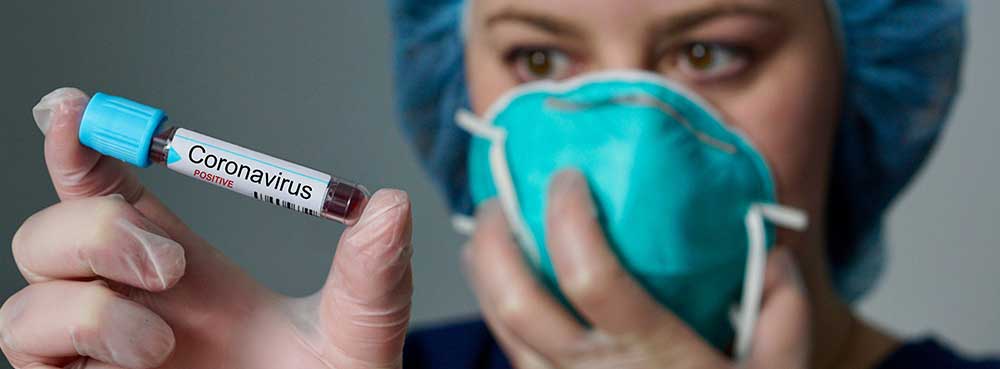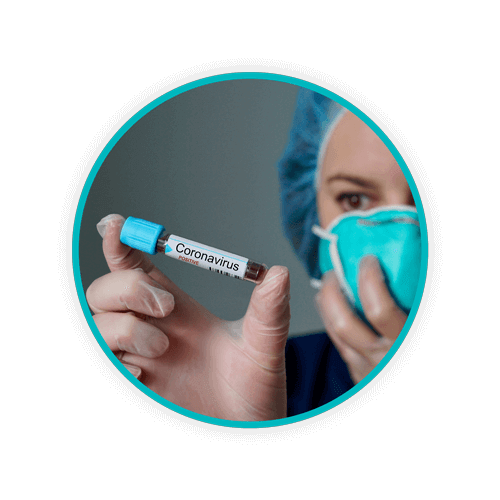COVID-19: Trustworthy Facts and Waste Handling Guidelines

Updated: March 20th, 2020.
Note 1. The situation is changing daily and readers should use hyperlinks for most recent updates.
Note 2. The World Health Organization (WHO) states trustworthy sources are essential for instituting evidence-based prevention measures against COVID-19.1 The following information is extracted from WHO, CDC, Johns Hopkins University and other trustworthy sources.
A. What is COVID-19?
Coronaviruses are a family of seven viruses common in many animals, including camels, cattle, cats, and bats.2 Common human coronaviruses usually cause mild to moderate upper-respiratory tract illnesses, like the common cold. However, rarely, animal coronaviruses can infect people and then spread between people such as with Middle East Respiratory Syndrome (MERS),3 Severe acute respiratory syndrome (SARS),4 and now COVID-19 (SARS.CoV-2) which commenced in China in Dec 2019.5
B. What are the symptoms of COVID-19?
Symptoms of COVID-19 infection may appear between 2 to 14 days after exposure and can include fever, cough and shortness of breath, however in some of cases the illness can be severe and fatal.6
C. World and U.S. situation
- Internationally. At Mar 20, 2020, 245,484 cases of COVID-19 from 163 countries/regions had been reported with an overall fatality rate of 3.9%.7
- U.S. 14,250 reported cases with 205 deaths.7 WHO report it took over 3 months for first 100,000 cases to be reported, and 12 days for the next 100,000.8
Note. To compare COVID-19 and flu incidence, U.S. has had 14,202 COVID-19 cases and 205 deaths (1.4% fatality rate),7 and CDC estimates that in U.S. as at Mar 7, 2020, this flu season has resulted in 36,000,000 flu cases with 370,000 hospitalizations and 22,000 deaths (0.06% fatality rate).9
D. How does COVID-19 spread?
On current evidence, CDC state spread from person-to-person is most likely among close contacts (about 6 feet) through respiratory droplets produced when an infected person coughs or sneezes.11 These droplets can land in the mouths or noses of nearby people or possibly be inhaled into their lungs. The risk of transmission from touching a contaminated surface or object (and then touching your nose or mouth) is possible but is not thought to be the main way the virus is spread.10
E. How “Infectious” is COVID-19?
Infectivity is calculated mathematically and termed “R0” (“R-naught”) which is the number of new cases likely to occur from each case. WHO state COVID-19 R0 is likely between 1.4-2.5,11 but a recent review by Wu et al puts COVID-19 R0 at 3-6.5.12 Such high R0 may account for the rapid spread of COVID-19 and makes it more infectious than the R0 of 3 for SARS,13 and the 1.0-5.7 for MERS.14By comparison influenza R0 is 1.3 (Seasonal) to 1.8 (Pandemic) and measles R0 is 12-18.15 With regard to fatality rates, the COVID-19 fatality rate of 3.9%,7 is less than SARS (11%),13 and MERS (35%).14
F. How can HCP protect themselves against COVID-19?
Clear updated guidelines for the protection of healthcare professionals (HCP) are available at WHO,16 OSHA17 and CDC.18 CDC advises that administrative rules and engineering controls, environmental hygiene, correct work practices, and appropriate use of personal protective equipment (PPE) are all necessary to prevent infections. All HCP who enter the room of a patient with suspected or confirmed COVID-19 should adhere to Standard and Transmission-Based Precautions, which along with hand hygiene may include gloves, gowns, respiratory and eye protection. In addition, HCP should take precautions when performing aerosol-generating procedures.18
G. What if I exhibit COVID-19-like symptoms?
If you develop COVID-19 symptoms or think you might have it, CDC advise the following:19
- Stay home except to get medical care
- Separate yourself from others in your home
- Wear a facemask when around others and before you enter a healthcare provider’s office
- Cover your coughs and sneezes
- Clean your hands often
- Avoid sharing household items
- Clean high-touch surfaces in your room daily (let someone else clean other areas of the home)
- Monitor your symptoms
- If symptoms worsen (difficulty breathing, persistent chest pain, confusion, bluish face) call 911 and inform them you have, or think you have, COVID-19.
H. How is COVID-19 waste handled?
OSHA, CDC and WHO state that waste from COVID-19 patients is handled as standard regulated medical waste (RMW).16-18
In their COVID-19 Infection Prevention Recommendations, CDC state, “Management of …. medical waste should also be performed in accordance with routine procedures”.18
A. For routine RMW containment onsite, CDC RMW Guidelines20 state:
- A single, leak-resistant biohazard bag is usually adequate for containment of regulated medical wastes, provided the bag is sturdy and the waste can be discarded without contaminating the bag’s exterior.
- Contamination or puncturing of the bag requires placement into a second biohazard bag.
- All bags should be securely closed for disposal.
B. For routine transport of RMW waste offsite the US Dept of Transport RMW 49 CFR 49 173.134(c) requires the above RMW plastic bags be contained in a rigid container,21 and the Hazardous Materials Table in 49 CFR 172.101 requires RMW be transported as “UN 3291 Regulated medical waste, n.o.s. or Clinical waste, unspecified, n.o.s. or (BIO) Medical waste, n.o.s., or Biomedical waste, n.o.s. or Medical waste, n.o.s.”22 (i.e. standard RMW transport packaging).
Note. Specimens from suspect COVID-19 cases and cultures of SARS-CoV-2 are Category B substances and must be packaged and transported as UN 3373 when sent offsite.23
I. How is COVID-19 waste treated?
As COVID-19 waste is standard regulated medical waste, the RMW chapter of the CDC 2003 Environmental Infection Control Guidelines20 states:
- Regulated medical wastes are treated or decontaminated to reduce the microbial load in or on the waste and to render the by-products safe for further handling and disposal.
- The treatment need not render the waste “sterile”
- Treatment processes are licensed under each state’s medical waste regulations and treatment methods may include autoclaving, incineration, chemical disinfection, grinding/shredding/disinfection methods, energy-based technologies (e.g., microwave or radiowave treatments), and disinfection/encapsulation method
J . Can reusable sharps containers be used for COVID-19 wastes?
Yes. COVID-19 waste is classified as standard RMW and reusable sharps bins may be used as normal, i.e. meets:
- OSHA Bloodborne Pathogen Standard 29 CFR 1910.1030 requirements.24
- FDA requirements for pre-market clearance.25
-
US DOT 49 CFR requirements, including:
- 173.134(c)2(x) requirements for sharps containers,21
- 49 CFR 172.10122 for Hazardous Materials transport, and
- 49 CFR 173.197(e)(3),26 requirements for reusable sharps containers:
(i) The sharps container is specifically approved and certified by the U.S. Food and Drug Administration as a medical device for reuse.
(ii) The sharps container must be permanently marked for reuse.
(iii) The sharps container must be disinfected prior to reuse by any means effective for the infectious substance the container previously contained.
(iv) The sharps container must have a capacity greater than 7.57 L (2 gallons) and not greater than 151.42 L (40 gallons) in volume.
Note 1. Recent research by van-Doremalen et al suggests SARS-CoV-2 virus may survive 2-3 days on some hard surfaces,27 but “surfaces” are not thought to be the main way the virus is spread.10 Early work showed simple disinfectants will easily kill SARS coronavirus.28
Note 2. Reusable sharps bins are not “patient equipment”18 and decontamination before removing from COVID-19 patient rooms is not required (i.e. no special handling, labelling or procedures are required).
Note 3. Under CDC COVID-19 Infection Prevention recommendations, personnel entering patient rooms (e.g. to exchange reusable sharps containers) are required to wear appropriate PPE as per facility protocols.18
K. Can reusable RMW bins be used for COVID-19 wastes?
Yes. COVID-19 wastes are classified as RMW and reusable RMW bins may be used provided the bins meet the normal requirements i.e.:
- Meet US Dept of Transport 49 CFR 49 173.134(c) for rigid containers,21 and are transported as UN 3291 in accord with 49 CFR 172.101.22
- Meet state RMW requirements for decontamination between uses.29
DOWNLOADABLE PDF VERSION OF THIS BLOG
References
1Novel Coronavirus (2019-nCoV). Situation Reports – 13 (Feb 2, 2020) World Health Organization. https://www.who.int/docs/default-source/coronaviruse/situation-reports/20200202-sitrep-13-ncov-v3.pdf?sfvrsn=195f4010_6. Accessed Mar 19, 2020.
2Human Coronavirus Type. Centers for Disease Control and Prevention. https://www.cdc.gov/coronavirus/types.html. Accessed Mar 19, 2020.
3WHO MERS-CoV Global Summary and Assessment of Risk, July 2019 (WHO/MERS/RA/19.1). Geneva, Switzerland: World Health Organization; 2019. https://apps.who.int/iris/bitstream/handle/10665/326126/WHO-MERS-RA-19.1-eng.pdf?ua=1. Accessed Mar 19, 2020.
4Consensus document on the epidemiology of severe acute respiratory syndrome (SARS). World Health Organization. https://www.who.int/csr/sars/en/WHOconsensus.pdf. Accessed Mar 19, 2020.
5Coronavirus Disease 2019 (COVID-19). Situation Summary. Mar 18, 2020. Centers for Disease Control and Prevention. https://www.cdc.gov/coronavirus/2019-ncov/cases-updates/summary.html?CDC_AA_refVal=https%3A%2F%2Fwww.cdc.gov%2Fcoronavirus%2F2019-ncov%2Fsummary.html. Accessed Mar 19, 2020.
6Coronavirus Disease 2019 (COVID-19). Symptoms. Centers for Disease Control and Prevention. https://www.cdc.gov/coronavirus/2019-ncov/symptoms-testing/symptoms.html. Accessed Mar 19, 2020.
7Coronavirus COVID-19 Global Cases. Center for Systems Science and Engineering, John Hopkins University, USA. https://gisanddata.maps.arcgis.com/apps/opsdashboard/index.html#/bda7594740fd40299423467b48e9ecf6. Accessed Mar 19, 2020
8Novel Coronavirus (2019-nCoV). Situation Reports – 59 (Mar 19, 2020) World Health Organization. https://www.who.int/docs/default-source/coronaviruse/situation-reports/20200319-sitrep-59-covid-19.pdf?sfvrsn=c3dcdef9_2. Accessed Mar 19, 2020.
9Weekly U.S. Influenza Surveillance Report. Centers for Disease Control and Prevention https://www.cdc.gov/flu/weekly/index.htm. Accessed Mar 19, 2020.
10Coronavirus Disease 2019 (COVID-19): How it Spreads. Centers for Disease Control and Prevention. https://www.cdc.gov/coronavirus/2019-ncov/about/transmission.html. Accessed Mar 19, 2020.
11Statement on the meeting of the International Health Regulations (2005) Emergency Committee regarding the outbreak of novel coronavirus (2019-nCoV). https://www.who.int/news-room/detail/23-01-2020-statement-on-the-meeting-of-the-international-health-regulations-(2005)-emergency-committee-regarding-the-outbreak-of-novel-coronavirus-(2019-ncov). Accessed Mar 19, 2020.
12Wu D, Wu T, Liu Q, Yang Z. The SARS-CoV-2 outbreak: what we know. International Journal of Infectious Diseases. Journal. Elsevier. https://www.ijidonline.com/article/S1201-9712(20)30123-5/fulltext. Accessed Mar 19, 2020.
13Consensus document on the epidemiology of severe acute respiratory syndrome (SARS). World Health Organization. https://www.who.int/csr/sars/en/WHOconsensus.pdf. Accessed Mar 19, 2020.
14WHO MERS-CoV Global Summary and Assessment of Risk, July 2019 (WHO/MERS/RA/19.1). World Health Organization, Geneva, Switzerland. https://apps.who.int/iris/bitstream/handle/10665/326126/WHO-MERS-RA-19.1-eng.pdf?ua=1. Accessed Mar 19, 2020
15Biggerstaff M, Cauchemez S, Reed C, Gambhir M, Finelli L. Estimates of the reproduction number for seasonal, pandemic, and zoonotic influenza: a systematic review of the literature. Centers for Disease Control and Prevention. BMC Infect Dis. BMC Infectious Diseases 2014, 14:480. http://www.biomedcentral.com/1471-2334/14/480. Accessed Mar 19, 2020.
16Infection prevention and control during health care when COVID-19 is suspected: Interim Guidance. Mar 19, 2020. World Health Organization. https://www.who.int/publications-detail/infection-prevention-and-control-during-health-care-when-novel-coronavirus-(ncov)-infection-is-suspected-20200125. Accessed Mar 19, 2020.
17COVID-19: Overview. Occupational Safety and Health Administration. https://www.osha.gov/SLTC/novel_coronavirus/controlprevention.html. Accessed Mar 19, 2020.
18Interim Infection Prevention and Control Recommendations for Patients with Suspected or Confirmed Coronavirus Disease 2019 (COVID-19) in Healthcare Settings. Mar 19, 2020. U.S. Centers for Disease Control and Prevention. https://www.cdc.gov/coronavirus/2019-ncov/infection-control/control-recommendations.html?CDC_AA_refVal=https%3A%2F%2Fwww.cdc.gov%2Fcoronavirus%2F2019-ncov%2Fhcp%2Finfection-control.html. Accessed Mar 19, 2020.
19What to do if you are sick. Mar 16, 2020. Centers for Disease Control and Prevention. https://www.cdc.gov/coronavirus/2019-ncov/if-you-are-sick/steps-when-sick.html. Accessed Mar 19,2020
20Regulated Medical Waste, Chapter I, Part 1 of Guidelines for Environmental Infection Control in Health-Care Facilities (2003) Updated: July 2019. https://www.cdc.gov/infectioncontrol/guidelines/environmental/background/medical-waste.html. Accessed Mar 19, 2020.
2149 CFR § 173.134 - Class 6, Division 6.2 - Definitions and exceptions. US Department of Transportation. https://www.law.cornell.edu/cfr/text/49/173.134. Accessed Feb 13, 2020.
2249 CFR 172.101 Hazardous Materials Table. US Department of Transportation. https://www.ecfr.gov/cgi-bin/text-idx?SID=ae15ede2730beed1bb677b2021049803&mc=true&node=se49.2.172_1101&rgn=div8. Accessed Mar 19, 2020.
23Interim Laboratory Biosafety Guidelines for Handling and Processing Specimens Associated with Coronavirus Disease 2019 (COVID-19). Mar 11, 2020. Centers for Disease Control and Prevention. https://www.cdc.gov/coronavirus/2019-ncov/lab/lab-biosafety-guidelines.html?CDC_AA_refVal=https%3A%2F%2Fwww.cdc.gov%2Fcoronavirus%2F2019-ncov%2Flab-biosafety-guidelines.html Accessed Mar 19, 2020.
2429 CFR 1910.1-30. OSHA Bloodborne Pathogens Standard. https://www.osha.gov/pls/oshaweb/owadisp.show_document?p_id=10051&p_table=STANDARDS. Accessed Mar 19, 2020.
25Guidance on the content and format of premarket notification [510(k)] submissions for sharps containers. Infection Control Devices Branch, Office of Device Evaluation, US Food and drug Administration. https://www.fda.gov/media/72328/download. Accessed Feb 13, 2020.
26Regulated Medical Waste: Sharps. 49 CFR 173.197(e)(3). US Department of Transportation. US Department of Transportation. https://www.law.cornell.edu/cfr/text/49/173.197. Accessed Feb 13, 2020.
27Van Doremalen N, Morris D, Holbrook M, et al. Aerosol and Surface Stability of SARS-CoV-2 as Compared with SARS-CoV-1. N Eng J Med , Mar 17, 2020. https://www.nejm.org/doi/pdf/10.1056/NEJMc2004973?articleTools=true. Accessed Mar 19, 2020.
28Rabenau HF, et al. Efficacy of various disinfectants against SARS coronavirus. Journal of Hospital Infection (2005) 61, 107–111. https://www.journalofhospitalinfection.com/article/S0195-6701(05)00044-7/pdf. Accessed Mar 19, 2020.
29State-by-State Regulated Medical Waste Resource Locator. Healthcare Environmental Resource Center (HERC). http://www.hercenter.org/rmw/rmwlocator.php. Accessed Feb 13, 2020.